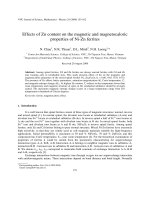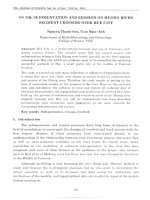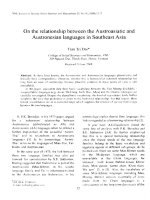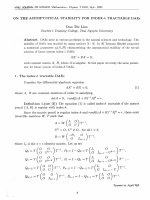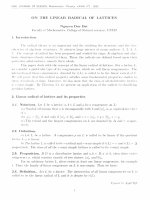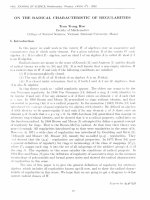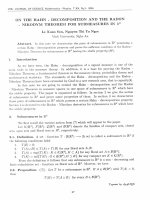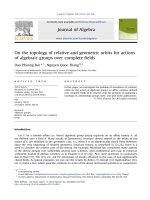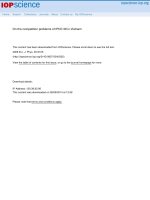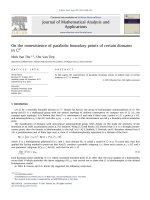DSpace at VNU: On the magnetic and magnetocaloric properties of perovskite La1-xSrxCoO3
Bạn đang xem bản rút gọn của tài liệu. Xem và tải ngay bản đầy đủ của tài liệu tại đây (109.62 KB, 3 trang )
Journal of Magnetism and Magnetic Materials 242–245 (2002) 760–762
On the magnetic and magnetocaloric properties of perovskite
La1ÀxSrxCoO3
Nguyen Hoang Luonga,*, Nguyen Chaua, Phan Manh Huonga, Dang Le Minhb,
Nguyen Ngoc Chaua, Bach Thanh Congb, M. Kurisuc
a
Faculty of Physics, Center for Materials Science, National University of Hanoi, 334 Nguyen Trai, Hanoi, Viet Nam
b
Department of Solid State Physics, National University of Hanoi, 334 Nguyen Trai, Hanoi, Viet Nam
c
School of Materials Science, Japan Advanced Institute of Science and Technology, Tatsunokuchi, Ishikawa 923-1292, Japan
Abstract
Structural, magnetic and magnetocaloric studies on La1ÀxSrxCoO3 (0.20pxp0.50) were reported. The crystal
structure of the samples is rhombohedral with x ¼ 0:2020:45 and is cubic with x ¼ 0:50: Magnetization, Curie
temperature (Tc ) and maximum magnetic-entropy change (DSmax ) depending on the Sr content in the samples are
discussed. La0.55Sr0.45CoO3 exhibits the largest value for DSmax and Tc among the compounds investigated. r 2002
Elsevier Science B.V. All rights reserved.
Keywords: Magnetization; Magnetocaloric effect; Magnetic oxides; Perovskite structure
The perovskite compounds La1ÀxSrxCoO3 are believed to exhibit spin glass (SG)-like properties at low
temperatures for xo0:20 and cluster glass (CG)-like
properties at higher Sr concentraion [1]. In high Sr
concentration range, x ¼ 0:50 is a typical concentration
corresponding to CG behavior [2]. Wang and Zhang [3]
suggested that the double-exchange interaction played
an important role in the ferromagnetic metallic conductivity of La1ÀxSrxCoO3. Takahashi et al. [4] have
studied the electronic structures of La1ÀxSrxCoO3 and
showed that La1ÀxSrxCoO3 becomes metallic near x ¼
0:20 because of the ferromagnetic coupling between O
2p and Co 3d electrons. Ibarra et al. [5] have found a
huge anisotropic magnetostriction in La1ÀxSrxCoO3
(x ¼ 0:30; 0.50). Recently, Chaudhary et al. [6] have
found moderately large magnetocaloric effect in
La1ÀxSrxCoO3 (0.05pxp0.40) with maximum entropy
change in La0.6Sr0.4CoO3 among samples studied. In the
present work, we report on our study of magnetic and
magnetocaloric properties of La1ÀxSrxCoO3 with
0.20pxp0.50.
*Corresponding author. Fax: 84-4-858-94-96.
E-mail address: (N.H. Luong).
Polycrystalline La1ÀxSrxCoO3 samples with x ¼ 0:20;
0.25, 0.30, 0.35, 0.40, 0.45, and 0.50 were prepared by
the conventional solid-state reaction technique from a
stoichiometric mixture of La2O3, SrCO3 and CoO at
pre-sintering temperature of 10001C for 15 h. After
regrinding and pressing for parallelepipeds, the samples
were again heat treated to 9501C for 12 h and then to
10501C for 10 h. The structure of the samples was
examined by Bruker X-ray diffractometer D5005. The
thermal stability associated with crystallization and
melting was determined by differential scanning calorimetry (DSC) and thermogravimetric analysis (TGA)
using TA Instruments apparatus SDT 2960 with a
heating rate of 201C/min. The magnetization measurements were performed with an SQUID magnetometer in
the temperature range between 1.7 and 300 K and in the
magnetic fields up to 70 kOe as well as with vibrating
sample magnetometer (VSM) DMS 880 in the fields up
to 13.5 kOe.
X-ray diffraction analysis revealed that all the samples
are of single phase. The crystal structure of the samples
is rhombohedral with x ¼ 0:2020:45 and is cubic with
x ¼ 0:50: These results are in good agreement with those
obtained by Ibarra et al. [5], who reported that the
0304-8853/02/$ - see front matter r 2002 Elsevier Science B.V. All rights reserved.
PII: S 0 3 0 4 - 8 8 5 3 ( 0 1 ) 0 1 0 1 6 - 2
N.H. Luong et al. / Journal of Magnetism and Magnetic Materials 242–245 (2002) 760–762
crystal structures of x ¼ 0:30 and 0.50 are rhombohedral
and cubic, respectively.
The DSC curves for all the samples show three sharp
endothermic peaks. The DSC curves for the samples
with x ¼ 0:25 and 0.45 are displayed in Fig. 1, as
examples, together with DSC and TGA curves for
starting material La2O3. It is suggested that, the first two
endothermic peaks are due to the decomposition of
La2O3 into intermediate oxide phases. It is interesting to
note that the third endothermic peak of both samples
around 931–9321C corresponds to the sharp endothermic peaks in the DSC curves for the starting materials
CoO and SrCO3 (not shown in the figure). This third
peak can be considered as corresponding to the reaction
forming a perovskite structure. Probably because of this
reason, several research groups have sintered La1ÀxSrxCoO3 at temperatures lower than those for La1ÀxSrx
MnO3 [5,6].
The zero-field-cooled (ZFC) and field-cooled (FC)
magnetization measurements were performed for all the
samples investigated. Representative results obtained for
x ¼ 0:30 and 0.50 at H=100 Oe are displayed in Fig. 2.
The Curie temperature, Tc ; of the samples determined
from these measurements is presented in Table 1. It can
be seen from Table 1 that Tc slightly increases with Sr
content up to x ¼ 0:45 then becomes somewhat lower in
the sample with x ¼ 0:50: These results differ from those
obtained by Chaudhary et al. [6] who reported that the
Curie temperature is almost independent of Sr concentration. The results of ZFC and FC magnetization
measurements obtained for the samples with xp0:40
revealed the divergence of the ZFC and FC measurements at a temperature Tir marking the appearence of
irreversible magnetic behavior (see Fig. 2). We observe
the divergence of ZFC and FC measurements in the
samples with highest Sr contents in this study (x ¼ 0:45
and 0.50) in the whole temperature range apart from the
paramagnetic region.
761
Fig. 2. Temperature dependence of magnetization for
La1ÀxSrxCoO3 with x ¼ 0:30 and 0.50. Open squares and open
circles represent the field-cooled (FC) and zero-field-cooled
(ZFC) curves, respectively.
Table 1
Curie temperature, Tc ; and maximum magnetic-entropy
change, DSmax ; as a function of the Sr concentration in
La1ÀxSrxCoO3
Fig. 1. DSC curves for La1ÀxSrxCoO3 with x ¼ 0:25 and 0.45.
Included are DSC and TGA curves for La2O3.
X
TC (K)
DSmax (J/kg K)
0.20
0.25
0.30
0.35
0.40
0.45
0.50
240
245
250
252
253
255
252
0.56
0.63
0.79
0.86
0.94
1.04
0.87
762
N.H. Luong et al. / Journal of Magnetism and Magnetic Materials 242–245 (2002) 760–762
Fig. 4. The magnetic-entropy change as a function of temperature for La0.55Sr0.45CoO3.
Fig. 3. Magnetization curves at 5 K for La1ÀxSrxCoO3.
Fig. 3 shows the magnetization curves at 5 K for all
La1ÀxSrxCoO3 samples. As can be seen from this figure,
magnetization clearly increases with Sr content from
x ¼ 0:20 up to x ¼ 0:45 then drops rather dramatically
in x ¼ 0:50: We note that, as discussed earlier, the
crystal structure is rhombohedral in the samples with
x ¼ 0:2020:45; whereas it is cubic in the sample with
x ¼ 0:50: We suggest that, with increasing Sr content
from 0.20 up to 0.45, the ferromagnetic exchange
interaction between Co3+ and Co4+ is enhanced,
causing the increase of magnetization of the compounds.
However, with higher Sr concentration x ¼ 0:50; corresponding to higher Co4+ concentration, lower-spin
states of Co3+ and Co4+ occur, leading to the decrease
of magnetization.
The isothermal M(H) curves for all La1ÀxSrxCoO3
samples have been measured at various temperatures
with small temperature intervals around the Curie
temperature in magnetic fields up to 13.5 kOe. The
entropy change resulting from the spin-ordering, induced by the applied magnetic field, can be obtained
according to the thermodynamic relation [7]
Z H max
DSðT; HÞ ¼
fqMðT; HÞ=qTgH dH:
ð1Þ
From the isothermal M(H) curves we evaluated the
entropy change, DS; as a function of temperature for all
the samples. Results for La0.55Sr0.45CoO3 are shown in
Fig. 4, as example. As is evident from Fig. 4, the sample
exhibits a maximum in DS near Tc : Similar behavior was
observed for other samples investigated. The maximum
magnetic-entropy change, DSmax ; has been derived for
all La1ÀxSrxCoO3 samples and presented in Table 1. As
one can see from Table 1, the sample with x ¼ 0:45
displays the largest value of 1.04 J/kg K for DSmax at an
applied magnetic field of 13.5 kOe. With higher Sr
concentration, i.e. x ¼ 0:50; DSmax decreases to a value
of 0.87 J/kg K. Our results for Sr concentrations up to
x ¼ 0:4 basically agree with those reported by Chaudhary et al. [6]. However, the Sr content studied in Ref. [6]
is limited only to x ¼ 0:4: This could be the reason that
authors of Ref. [6] could not observe the largest value
for DSmax in x ¼ 0:45: Thus, La0.55Sr0.45CoO3 can be
considered as an active magnetic refrigerant (AMR)
material near 255 K.
The authors are grateful to the Vietnam National
Program for Natural Sciences for financial support and
the VNU project QGTD-00-01 for a partial support.
References
[1] M. Itoh, I. Natori, S. Kubota, K. Motoya, J. Phys. Soc.
Jpn. 63 (1994) 1486.
[2] D.N.H. Nam, K. Jonason, P. Nordblad, N.V. Khiem, N.X.
Phuc, Phys. Rev. B 59 (1999) 4189.
[3] Z.L. Wang, J. Zhang, Phys. Rev. B 54 (1996) 1153.
[4] H. Takahashi, F. Munakata, M. Yamanaka, Phys. Rev. B
57 (1998) 15211.
[5] M.R. Ibarra, R. Mahendiran, C. Marquina, B. GarciaLanda, J. Blasco, Phys. Rev. B 57 (1998) R3217.
[6] S. Chaudhary, V.S. Kumar, S.B. Roy, P. Chaddah, S.R.
Krishnakumar, V.G. Sathe, A. Kumar, D.D. Sarma, J.
Magn. Magn. Mater. 202 (1999) 47.
[7] A.M. Tishin, J. Magn. Magn. Mater. 184 (1998) 62.
